Creating Effective Data Labeling Guidelines for Autonomous Vehicles
Autonomous vehicles and robots must safely navigate the real world, and that requires integrating human feedback at scale. The Kognic Platform delivers the world's most productive annotation platform for autonomy data, combining optimized tools, proven workflows, and intelligent auto-label integration to help you get the most annotated sensor-fusion data for your budget.
Creating a dataset for supervised machine learning
Machine learning models learn from the data they're trained on, and for autonomous systems, that data comes from complex sensors like lidars, cameras, and radars. At Kognic, we believe annotation is programming—your labeling guidelines directly shape how your models perceive the world. Inconsistent or unclear guidelines lead to systematic errors in your dataset, which then become systematic errors in your models. Since annotation is often performed by distributed teams with diverse backgrounds, guidelines must be crystal clear and interpreted consistently by everyone.
Similarities between ML projects and traditional software projects
Just as software projects require rigorous requirements management, machine learning projects need equally rigorous annotation guidelines.

Lifecycle of an ML project vs traditional software project
In traditional software development, writing necessary, specific, understandable, accurate, feasible, and testable requirements is critical for success. The same principles apply to annotation guidelines in ML projects—yet they're often overlooked. At Kognic, we treat annotation guidelines with the same rigor as software requirements, because finding mistakes during guideline review is far cheaper than discovering them in production.
Our approach
At Kognic, we provide the tools and expertise to create, version control, and test your annotation guidelines—ensuring they capture all functional needs with zero ambiguity. Through our platform, you can validate guidelines by having multiple annotators independently annotate test cases and measure agreement levels, ensuring consistent interpretation across your entire workforce.
As the leader in autonomy data annotation, we help you maximize the value of every annotation dollar through superior productivity, quality assurance, and intelligent automation. Our Data Quality Analytics tool continuously evaluates your dataset quality and connects results back to your guidelines, enabling rapid iteration and improvement. This integrated approach—combining optimized annotation tools, proven workflows, and quality analytics—is how Kognic delivers more annotated autonomy data for your budget than anyone else.
Want to learn more? Watch the talk "It all starts with a consistent labeling guideline" held at the Gothenburg AI Alliance Conference to discover our way of working.
Share this
Written by

.png?width=2000&name=kognic%20logo-black%20(1).png)
